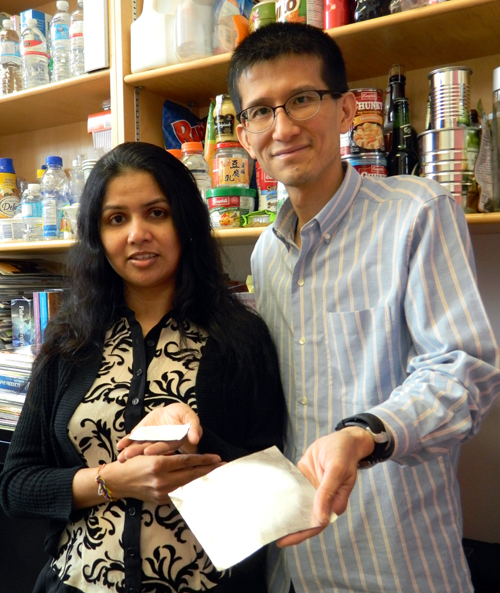
If you’ve ever bought a ready-to-eat package of sushi at the grocery store, you may have noticed that the person who prepared and wrapped your meal included a blob of wasabi on the tray. It’s a convenient way to add some pungent flavour to your sushi, but you might not know that it also serves another purpose: it protects your food from micro-organisms.
As food science professor Loong-Tak Lim explains, wasabi contains allylisothiocyanate (AITC), a natural ingredient and potent anti-microbial that kills yeast and bacteria (AITC is also found in cabbage and mustard). However, not every food is enhanced by the strong flavour of wasabi, so Lim has developed a carrier system to deliver it to the food.
Instead of using a synthetic form of AITC, he uses a derivative from ground mustard powder. He explains that although the two are chemically the same, many consumers prefer ingredients that come from natural sources. Lim and post-doc Suramya Mihindukulasuriya have found a way to use nanotechnology to spin tiny fibres that encapsulate the AITC or other preservatives in the packaging. They have patented this process.
“The conventional approach to adding preservatives has been to add them to the food,” explains Mihindukulasuriya. “But the processing of the food may break down the preservative. By having the preservative in the packaging, we don’t need as high a concentration, and it still enhances the shelf-life, safety and quality of the food.”
Known as “active packaging,” this type of packaging doesn’t only contain a food product; it responds to changes in the environment and the food itself, explains Lim. In Mihindukulasuriya’s packaging, the membrane made up of the encapsulating fibres responds to a certain level of moisture and releases a preservative to prevent spoiling. Other active packaging materials can respond to heat or light.
Mihindukulasuriya is working with a preservative called hexanal, the volatile organic compound you smell when you cut grass or slice a cucumber. Hexanal helps to preserve the cell membranes of fruits and vegetables so they don’t become soft or soggy as they ripen. The preservative also has some anti-microbial properties, which are activated by heat and humidity.
Mihindukulasuriya calls her technique of enclosing the preservative using ultra-high electrical forces “electrospinning.” Lim jokes that “we are like Spiderman, spinning tiny fibres.” And the fibres are tiny – about 400 times smaller than a human hair. The biodegradable polymer encloses the active ingredients. When exposed to humidity or water, it absorbs some of the water and becomes more permeable, releasing the hexanal.
In her PhD studies, Mihindukulasuriya developed a form of “intelligent packaging.” Lim explains that intelligent packaging undergoes changes to communicate with the consumer. Although the packaging may not preserve or protect the food inside, it can alert the potential purchaser to changes in the environment that might affect food quality. Mihindukulasuriya developed an oxygen indicator that is activated by ultraviolet radiation. When there is little or no oxygen in the package, the indicator is white, but if the package is damaged or torn, allowing oxygen to enter, the indicator turns blue.
This matters because oxygen causes rapid deterioration of some foods, and higher levels of oxygen encourage the growth of more micro-organisms. These foods are sealed in vacuum packs or in packages flushed with nitrogen to remove the oxygen, but if the package becomes damaged at some point, oxygen can get inside. That’s where Mihindukulasuriya’s product comes in: a label with a blue line would indicate that the package should not be purchased.
What’s next in active and intelligent packaging? Mihindukulasuriya is planning to develop a compound that will detect the volatile compounds produced by food when it spoils and indicate to consumers that the food should not be eaten. The technique would supplement expiry dates, which are only estimates based on typical situations. Not only would this packaging warn people if the food had spoiled, it would also reassure them when it was safe to eat – even if the expiry date had passed. “People throw away lots of food that has expired but is still perfectly good to eat,” says Lim.
How will shoppers respond to these new packaging concepts? It’s hard to know. What is well-received in one part of the world may be unpopular in another. “Creating active and intelligent packaging is incredibly tricky,” Lim adds. “Out of the hundreds of polymers and thousands of solvents, you have to find the ones that will work in the ways you want it to. It takes a lot of patience and persistence.” Mihindukulasuriya clearly has both.